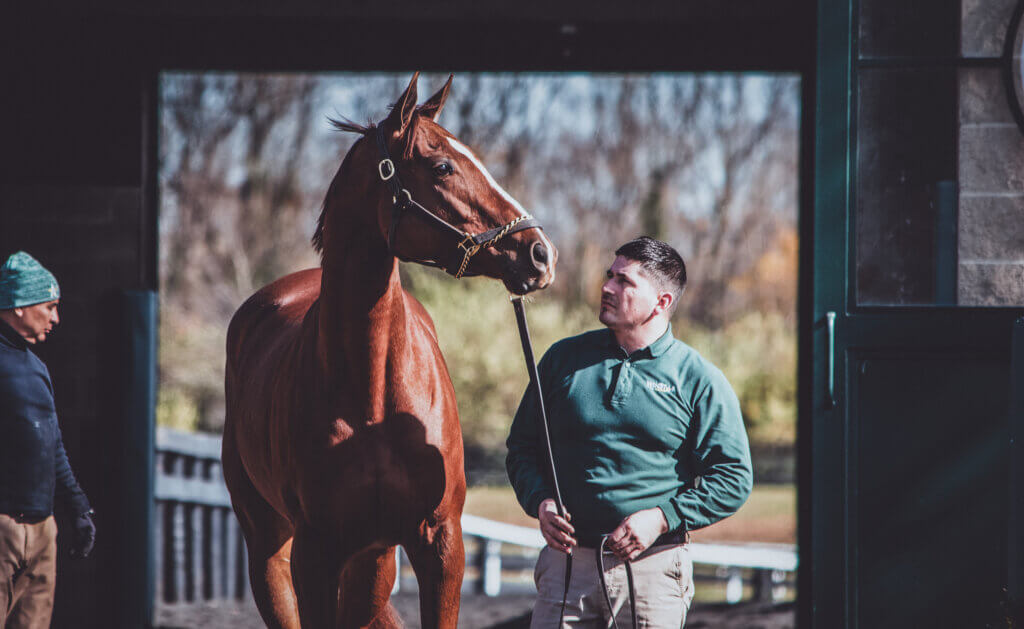Photography by: Amplify Horse Racing, Cady Coulardot
In the US, racing takes place on either dirt, turf or synthetic surfaces. Trainers choose to run their horses on the surface that is most suitable for them which can depend on their breeding, gait and overall physique as well as their past performance on a particular type of surface.
Like most other sports, horse racing takes place in different weather conditions and while extreme weather may lead to cancellations, generally horses will still run in the rain and on wet surfaces.
In the event of wet weather various preparations are put in place.
What happens when it rains?
Specifically on dirt surfaces, when it is raining the track may be “sealed”. This is when heavy rollers “seal” the track, which prevents water from seeping into the lower levels. Periodically, a “float”, which is a lighter slab of metal, will be pulled over the track to squeeze off surface water.
For turf surfaces, if a heavy rainstorm strikes on the day of the race, it is common for turf races to be taken “off the turf” and contested over dirt or synthetic surfaces instead.
While these safety measures are put in place for wet surfaces and it may be intuitive to assume that if the surface is not perfect then it may not be safe, data suggests that this is not the case.
Statistics: what does the data say?
Over the last three decades a number of scientific studies have assessed correlations between racetrack injuries in Thoroughbred racehorses in North America and the specific surfaces they were running on.
Early Studies
In the early 1990s, a study at a Minnesota Thoroughbred racetrack examined weather conditions and track surface properties such as moisture content, composition, strength, and friction between the track and horse hooves. The findings showed no link between weather conditions and racehorse injuries or breakdowns.
Friction between hooves and the track was consistent, and weather variables did not correlate with injuries or breakdowns.
John Doe Tweet
While the surface moisture varied, the cushion layer’s moisture stayed constant. Surfaces near the starting chutes were more compacted, and the area next to the rail was softer than the middle of the track. Despite these differences, friction between hooves and the track was consistent, and weather variables did not correlate with injuries or breakdowns.
Recent Studies
In a far more recent and extensive study, Dr Euan Bennet and Professor Tim Parkin analyzed the incidence of musculoskeletal fatalities in the years 2021 and 2022 by track conditions on both dirt and turf surfaces across the US.
Taking in data from over 400,000 starts on dirt over the two year period, the study which factored in every possible racing condition including those resulting from wet weather (ie. those described as wet, sloppy or muddy surfaces) and concluded that there were no statistically significant differences in incidences associated with track conditions.
From over 400,000 starts on dirt over a two year period… there were no statistically significant differences in incidences associated with track conditions.
John Doe Tweet
Similarly, during the same two-year period, up to 95,000 starts that took place on turf surfaces were assessed for correlation between any fatalities during the period and the surface conditions. Once again with conditions that spanned across Firm, Good, Soft and Yielding, there were deemed to be no statistically significant differences in incidences.
Conclusion
Therefore, whilst due diligence is carried out by racetracks when track surfaces are altered by wet weather and races may be moved onto a different surface or canceled altogether during inclement conditions, the statistics would suggest that wet tracks are no more dangerous than any other racing surface.
SOURCES
Euan Bennet, Tim D. H. Parkin (2023) EID racing fatalities by surface and track condition analysis. The Jockey Club
Stamatis Panagiotis Georgopoulos, Tim D. H. Parkin (2016) Risk factors for equine fractures in Thoroughbred flat racing in North America. School of Veterinary Medicine, College of Medical, Veterinary and Life Sciences, University of Glasgow.
Charles Clanton PhD, Calvin Kobluk DVM, DVSc, R. Ashley Robinson BVSc, MPH, PhD, and Bradley Gordon MS, DVM (1991) Monitoring surface conditions of a Thoroughbred racetrack. AVMA Publications.



